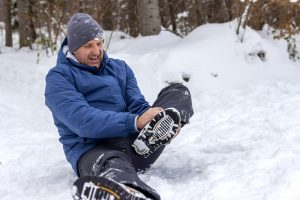5 Tips to Prevent ACL Injury During Winter Sports
 Exercise has several health benefits, both physical and mental. At Orthopaedic Hospital of Wisconsin, we see a clear link between health and exercise and we recommend exercising year-round. But staying active does not make you immune to injury. One of the more frequent injuries in winter sports requiring an extensive recovery is a sprained knee – usually affecting the anterior cruciate ligament (ACL). In the blog post below, OHOW Shorewood Physical Therapist Greg Ketz, PT, DPT, lays out 5 tips to prevent ACL sprain and injury during winter sports.
Exercise has several health benefits, both physical and mental. At Orthopaedic Hospital of Wisconsin, we see a clear link between health and exercise and we recommend exercising year-round. But staying active does not make you immune to injury. One of the more frequent injuries in winter sports requiring an extensive recovery is a sprained knee – usually affecting the anterior cruciate ligament (ACL). In the blog post below, OHOW Shorewood Physical Therapist Greg Ketz, PT, DPT, lays out 5 tips to prevent ACL sprain and injury during winter sports.
Winter Sports and ACL Injury

During the winter months, many Wisconsin residents participate in winter activities such as downhill skiing, cross-country skiing, snowshoeing, ice skating, snowboarding, and traditional sledding. And while a common injury in the winter can be simply “slipping on the ice” all of these activities come with some varying degree of orthopedic risk (yes, I will see at least one middle-aged father in the physical therapy clinic each winter season who thinks they’re Clark Griswold).
One of the more frequent injuries in winter sports requiring an extensive recovery is a sprained knee – usually affecting the anterior cruciate ligament (ACL). The ACL is a big player in stabilizing your knee joint and is one of the most commonly injured in sports. An injury to the ACL usually involves a sudden stop or a change in direction. Unfortunately, there is no absolute prevention when talking about sports injuries. Sometimes even the most prepared athlete can suffer from an injury that requires surgical intervention and/or extensive physical therapy despite doing all the right things.
Here are a few tips to help you avoid spending too much time with your physical therapist or orthopedic surgeon this winter season:
-
Prepare
First and foremost, any activity should be approached with graded exposure, either through training and/or the actual activity. Simply stated, if you’re downhill skiing for the first time again in 15 years, you probably shouldn’t go for that black diamond you shredded when you were 25. Any form of impact exercise year-round can help keep your body in shape to resist larger stress and hopefully avoid serious injury. Start early, and stay committed.
-
Pay Attention To How You Move
When your knees are stiff or “locked” in extension (straight legs) your ligaments take on more stress and are at risk for an injury. Practice exercises with an emphasis on bending your knees and hips. This allows your quads, hamstrings, glutes, and core to work as efficiently as possible to absorb your landing – not just your knee joint.
Alignment can also be important. Try to avoid your knee from caving in or bowing out. This is mostly about muscle memory, so repetition and form are key. As you improve – progress with speed and/or difficulty.
Here’s a good starter pack:
- Box Jumps (on & off)
- Squat Jumps
- Jumping Lunges
-
Strengthen Hamstrings, Quadriceps, Glutes
Very simply, the stronger your quadriceps, hamstrings, and glutes are, the less likely you are to sustain a significant knee injury.
Here are some examples:
- RDL or Single Leg Deadlift
- Lunges
- Squats or Split Squats
-
Maintain Core Strength
A strong and stable core helps you with any activity by allowing the other muscles to be more efficient and by helping to control your body.
These are two of the most common that can also help to strengthen the glutes:
- Bridge
- Plank
-
Hit the Warming House
Lastly, if you’re tired, listen to your body and take a break. When your body is fatigued, you are more likely to use poor form, putting yourself at increased risk of injury. This goes for your workouts as well.
If you should experience an ACL sprain or other injury, our team of orthopedic specialists is here to help you heal and get back to the winter sports you love. To make an appointment with Greg Ketz or any other specialist, request an appointment online or call (414) 961-6800.







